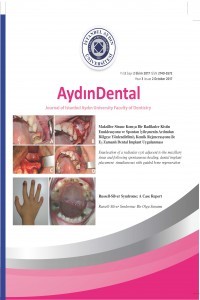The Effect of Bleaching Treatment and Tea on Color Stability of Two Different Resin Composites
beyazlatma, rezin kompozit, renk, renklenme
The Effect of Bleaching Treatment and Tea on Color Stability of Two Different Resin Composites
bleaching, resin composite, color, discoloration,
___
- Gresnigt MM, Kalk W, Ozcan M. Randomized controlled split-mouth clinical trial of direct laminate veneers with two micro-hybrid resin composites. J Dent 2012;40(9):766-75.
- Martin N, Jedynakiewicz NM, Fisher AC. Hygroscopic expansion and solubility of composite restoratives. Dent Mater 2003;19(2):77-86.
- Villalta P, Lu H, Okte Z, Garcia-Godoy F, Powers JM. Effects of staining and bleaching on color change of dental composite resins. J Prosthet Dent 2006;95(2):137-42.
- Iazzetti G, Burgess JO, Gardiner D, Ripps A. Color stability of fluoride- containing restorative materials. Oper Dent 2000 Nov-Dec;25(6):520-5.
- Abu-Bakr N, Han L, Okamoto A, Iwaku M. Color stability of compomer after immersion in various media. J Esthet Dent. 2000;12(5):258-63.
- Fujita M, Kawakami S, Noda M, Sano H. Color change of newly developed esthetic restorative material immersed in food-simulating solutions. Dental Mater J 2006;25(2):352-9.
- Tunc ES, Bayrak S, Guler AU, Tuloglu N. The effects of children’s drinks on the color stability of various restorative materials. J Clin Pediatr Dent 2009;34(2):147-50.
- Domingos PA, Garcia PP, Oliveira AL, Palma-Dibb RG. Composite resin color stability: influence of light sources and immersion media. J Appl Oral Sci 2011;19(3):204-11.
- Gurgan S, Yalcin F. The effect of 2 different bleaching regimens on the surface roughness and hardness of tooth- colored restorative materials. Quintessence Int 2007;38(2):83-7.
- Li Q, Yu H, Wang Y. Colour and surface analysis of carbamide peroxide bleaching effects on the dental restorative materials in situ. J Dent 2009;37(5):348-56.
- Garoushi S, Lassila L, Hatem M, Shembesh M, Baady L, Salim Z, et al. Influence of staining solutions and whitening procedures on discoloration of hybrid composite resins. Acta Odontol Scand 2013;71(1):144-50.
- Rosentritt M, Lang R, Plein T, Behr M, Handel G. Discoloration of restorative materials after bleaching application. Quintessence Int 2005;36(1):33-9.
- Celik C, Yuzugullu B, Erkut S, Yazici AR. Effect of bleaching on staining susceptibility of resin composite restorative materials. J Esthetic Restor Dent 2009;21(6):407-14.
- Hachiya Y, Iwaku M, Hosoda H, Fusayama T. Relation of finish to discoloration of composite resins J Prosthet Dent 1984;52(6):811-4.
- Fontes ST, Fernandez MR, de Moura CM, Meireles SS. Color stability of a nanofill composite: effect of different immersion media. J Appl Oral Sci 2009;17(5):388-91.
- Fay RM, Servos T, Powers JM. Color of restorative materials after staining and bleaching. Oper Dent 1999;24(5):292-6.
- Seghi RR, Hewlett ER, Kim J. Visual and instrumental colorimetric assessments of small color differences on translucent dental porcelain. J Dent Res1989;68(12):1760-4.
- Yu H, Pan X, Lin Y, Li Q, Hussain M, Wang Y. Effects of carbamide peroxide on the staining susceptibility of tooth-colored restorative materials. Oper Dent 2009;34(1):72-82.
- Gerlach RW, Gibb RD, Sagel PA. A randomized clinical trial comparing a novel 5.3% hydrogen peroxide whitening strip to 10%, 15%, and 20% carbamide peroxide tray-based bleaching systems. Compend Contin Educ Dent Suppl 2000(29): 22-8.
- ISSN: 2149-5572
- Yayın Aralığı: Yılda 3 Sayı
- Başlangıç: 2015
- Yayıncı: İstanbul Aydın Üniversitesi
The Effect of Smoking on Postoperative Period of Extraction of Impacted Mandibular Third Molars
Seda YILMAZ, Hatice HOŞGÖR, Özlem Akbelen KAYA, Burcu BAŞ, Bora ÖZDEN
Rüdiger JUNKER, Andreas LEINER, Daniela ZITSCH, Thomas ULRICH, Wilhelm FRANK, Adrian KASAJ
Orthodontic and Surgical Approach: Accelerated Osteogenic Orthodontics
Orhan AKSOY, Fatma YILDIRIM, M İrfan KARADEDE
Veillonella Spp. Infection As a Rare Cause for Early Multiple Dental Implant Failures: A Case Report
Mustafa TUNALI, Cenker Zeki KOYUNCUOGLU, Burak SELEK, Bayhan BEKTORE, Mustafa OZYURT, Rana ÇULHAOĞLU
Immediate Prosthetic Treatment of an Edentulous Patient With “All-On-4®” Concept
Alper UYAR, Simel AYYILDIZ, Bülent PİŞKİN, Can DURMAZ
Oroantral Fistula Associated with Destructive Periodontitis
The Effect of Bleaching Treatment and Tea on Color Stability of Two Different Resin Composites
Funda Öztürk BOZKURT, Tuğba Toz AKALIN, Burcu GÖZETİCİ, Gencay GENÇ, Harika Gözükara BAĞ
